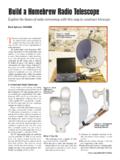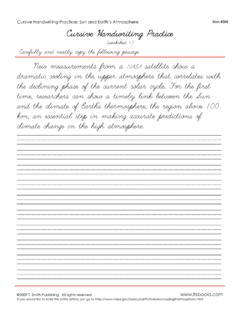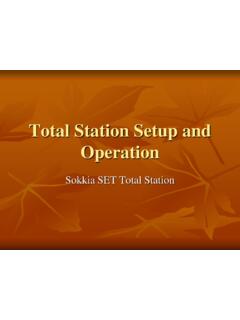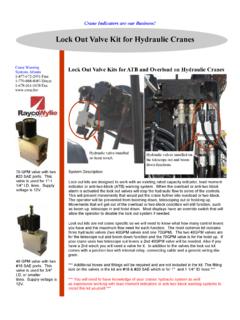Transcription of A Simple Guide to Backyard Astronomy Using Binoculars or …
1 A Simple Guide to Backyard Astronomy Using Binoculars or a Small telescope Assembled by Carol Beigel Where and When to Go Look at the Stars Dress for the Occasion Red Flashlight How to Find Things in the Sky Charts Books Gizmos Binoculars for Astronomy Telescopes for Backyard Astronomy Star Charts List of 93 Treasures in the Sky with charts Good Binocular Objects Charts to Get Oriented in the Sky Messier Objects Thumbnail Photographs of Messier Objects A Simple Guide to Backyard Astronomy Using Binoculars or a Small telescope The Earth's Moon Moon Map courtesy of Night Sky Magazine A Simple Guide to Backyard Astronomy Using Binoculars or a Small telescope A Simple Guide to Backyard Astronomy Using Binoculars or a Small telescope assembled by Carol Beigel in the Summer of 2007. The wonderment of the night sky is a passion that must be shared. Tracking the phases of the Moon, if only to plan how much light it will put into the sky at night, and bookmarking the Clear Sky Clock, affectionately known as the Cloud Clock become as common as breathing.
2 The best observing nights fall about a week after the Full Moon until a few days after the New Moon. However, don't wait for ideal and see what you can see every night no matter where you are. I offer this Simple Guide to anyone who wants to look upward and behold the magnificence of the night sky. Light pollution complicates observing the night sky if you live near a city as the brightness of the sky will determine how much you will be able to see. Star gazing in the Washington area can be a wonderful experience in your own Backyard or an incredibly fantastic experience if you are willing to drive 2 to 8. hours to find a dark sky. For more information about curbing light pollution and saving money at the same time, or to see a light pollution map, check out All it takes to get started is a lawn chair and a pair of Binoculars Then you will want to know where to look for beautiful things in the sky, and how to know where you have pointed your optics Soon you will want something to hold the Binoculars steady, bigger Binoculars , a more comfortable lounge chair, warmer clothes and something to keep the dew off your optics well, Pandora's Box has opened, and you realize that aperture is everything, the cost of mounting the optics and accessorizing them far exceeds the cost of the optics themselves, and you are starting to wonder how nice a gift you need to buy for your spouse so that you can acquire a new piece of astro stuff.
3 Where and When to Go to look at the Stars Your Backyard is a good place to start Most local Astronomy clubs have public outreach programs and advertise public viewing nights. Here is a list of local Astronomy clubs in the Washington, area. Northern Virginia Astronomy Club (NOVAC) /. A Simple Guide to Backyard Astronomy Using Binoculars or a Small telescope Howard Astronomical League (HAL) Astronomical Society of Greenbelt University of Maryland, College Park, Public Astronomy Programs Southern Maryland Astronomical Society (SMAS) The finest website ever to check out the condition of the sky and locations for observing is the Clear Sky Clock at If you like camping, try attending a star party. Even if you don't own a telescope , star parties are fun to attend. People with big and small, homemade or expensive telescopes are happy to show them off and let you take a look.
4 They are great opportunities to see and try things before you buy. Some of the ones I am familiar with are listed below, but there are wonderful star parties all over the country: The Mason-Dixon Star Party near Lancaster, PA usually in June or July Stargaze in the Spring, and the No-Frills in the Fall at Tuckahoe State Park, MD sponsored by the Delmarva Stargazers club Almost Heaven Star party in August at the Mountain Institute on Spruce Knob, in West Virginia The Black Forest Star Party in Cherry Springs, PA in September Dress for the Occasion! Always carry a jacket, hat and boots. The cosmos is a very, very cold place, and it just sucks the warmth right out of you in the absence of sunlight. By day, the sun can be intense and burn your skin. A daytime, safari-style hat with a broad brim and covers the back of your neck, though no fashion statement, will help protect your face and neck from getting sunburned.
5 Sun screen, lip balm, moisturizing lotion and insect repellent are four things you do not want to be without in the middle of nowhere! Even in summer, most astronomers battle cold temperatures at night! Changing the clothes next to your skin at dusk, wearing wool socks and a hat that covers your ears will go a long way to keeping you comfortable. Dew can be a problem and soaks through clothing, so water resistant outerwear is a good idea. A pair of gloves comes in handy when the dew freezes on your equipment Wearing a hat will help keep your feet warm as fifty percent of your body heat escapes from the top of your head. If you find that insulated boots are too bulky, try a pair of NEOS Overshoes. They fit over your regular shoes, are very light weight, pack flat, and keep your feet warm and dry in water, mud, frost and snow. A Simple Guide to Backyard Astronomy Using Binoculars or a Small telescope Red Flashlight A flashlight that shines a red and not a white light is essential for navigating your way around in the dark on the observing field and reading the star charts.
6 You can either cover a flashlight you have with rubylith, a red cellophane, or buy one with a red LED bulb. Many clubs that sponsor public outreach programs will be able to provide you with red cellophane for your flash light when you arrive. I have come to prefer the kind of light you wear around your head so your hands are free. I really like my Petzl Tactikka Plus LED. Headlamp I bought at REI. It has a red plastic cover that comes down over the white light and has 3 different levels of brightness and adjustment angles. WHY RED? Human eyes adapt to the dark by dilating the pupils and filling up with a chemical called visual purple. A white light will cause immediate pain and take your eyes another 30 minutes to readjust to the dark. A red light does not cause the visual purple to disappear or cause howling among the astrophotographers trying to take pictures.
7 How to Find Things in the Sky (and figure out what you are looking at!). There are many maps of the sky available. The selection is overwhelming, so I will name my favorites. Photographs on the covers of Astronomy books and maps are spectacular, but you will NOT see those objects in that beautifully illustrated way in a small telescope or with a pair of Binoculars . You also will not be able to see the color shown in these photographs, so don't be disappointed at the outset! I own two bookshelves full of atlases and star charts, yet I cannot read them in the dark with a red flashlight because the print is too small and/or they cram so many objects on the chart that you can't tell where they are. Many of the charts included in this Guide will be ones I created for myself and are specifically limited to large, bright objects you can see with a small telescope or Binoculars .
8 Most of the objects can be seen to some degree with the naked eye in a dark sky, and many of them can be found Using optics in the horribly light polluted skies here in the Washington, area! A Simple Guide to Backyard Astronomy Using Binoculars or a Small telescope Most amateur astronomers use a combination of charts and gizmos to assist them in finding celestial objects. There is even software that can be used on a laptop computer or Pocket PC that will Guide you or a telescope to targets you choose. Many new telescopes come with "Go-To" motors and software built into them or something like Sky Commander can be used with large Dobsonian telescopes to find and track objects in the sky. Planetarium Software Planetarium programs can be installed on a computer that will show you what is available for viewing at anytime - both past and future. Most of my favorites are available for free on the web.
9 Hallo Northern Sky at: WinStars at Cartes du Ciel at The Sky Tonight at Pocket Sky runs on a pocket pc, but is not free, and can be purchased at The What's Up Page on the Orion telescope website Learning Center at Books and Planispheres If you were to buy only one book on Astronomy , I would very highly recommend NIGHTWATCH, A Practical Guide to Viewing the Universe (Fourth Edition) written by Terence Dickinson ($35). It is large enough to easily see the maps and charts in the dark, and is spiral bound. The photographs are astounding, but do remember they are probably stacked (composites of several photographs) and edited to display different wavelengths of light (color) that small optics will not show you. Make sure you buy the Fourth Edition as it just came out and has been revised and expanded to use through 2018. A Simple Guide to Backyard Astronomy Using Binoculars or a Small telescope The Night Sky Planisphere published by David Chandler easy to use and has the least distortion of the constellation images.
10 You can order one specifically for your latitude. Mine is the 30-40 degree one You rotate the wheel until it points to the day and time, and it shows you what is visible in the sky The Northern horizon is on the front side, and you simply turn it over to see the Southern horizon. Both The Night Sky Planisphere and the Sky Atlas for Small Telescopes are published by David Chandler at . Binocular Highlights: 99 Celestial Sites by George Seronik is available at Sky and telescope magazine's Pocket Sky Atlas by Roger Sinnott is one of the best of all time and is available at I keep my copy in the car along with the Canon IS Binoculars so I never leave home without them! Of course, my absolute favorite star charts are the ones I made for myself and included later in this Guide . They are designed with light pollution factored in so that only the brightest stars are shown on the charts.







